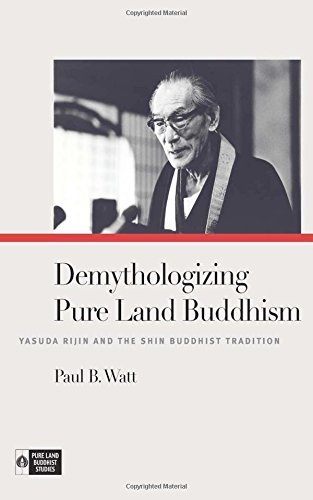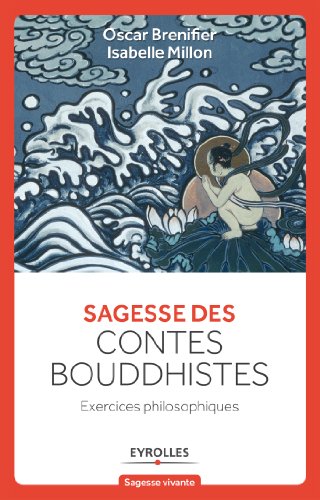
By Paul B. Watt
The precise natural Land sect of eastern Buddhism, or Shin Buddhism, grew out of the lessons of Shinran (1173–1262), a Tendai-trained monk who got here to doubt the efficacy of that culture in what he considered as a degenerate age. Shinran held that even these not able to meet the necessities of the conventional Buddhist direction might reach enlightenment throughout the adventure of shinjin, “the entrusting mind”—an expression of the profound consciousness that the Buddha Amida, who can provide delivery in his natural Land to all who belief in him, used to be not anything except the real foundation of all life and the maintaining nature of humans. Over the centuries, the subtleties of Shinran’s teachings have been usually misplaced. complex rituals constructed to concentration one’s brain in the interim of demise so one may possibly shuttle to the natural Land unimpeded, and a wealthy inventive culture celebrated the instant whilst Amida and his retinue of bodhisattvas welcome the demise believer. what's extra, many Western interpreters tended to augment this view of natural Land Buddhism, seeing in it definite parallels to Christianity.
This quantity introduces the concept and chosen writings of Yasuda Rijin (1900–1982), a latest Shin Buddhist philosopher affiliated with the Otani, or Higashi Honganji, department of Shin Buddhism. Yasuda sought to restate the lessons of Shinran inside a contemporary culture that all started with the paintings of Kiyozawa Manshi (1863–1903) and prolonged during the writings of Yasuda’s academics Kaneko Daiei (1881–1976) and Soga Ryōjin (1875–1971). those males lived in the course of the interval of Japan’s swift modernization and considered the Shin culture as owning existential value for contemporary women and men. For them, and Yasuda specifically, Amida didn't exist in a few other-worldly paradise yet relatively Amida and his natural Land have been to be skilled as lived realities within the current. within the writings and lectures provided the following, Yasuda attracts on not just classical Shin and Mahayana Buddhist resources, but in addition the idea of Nishida Kitarō (1870–1945), the founding father of the Kyoto college of philosophy, and glossy Western philosophers reminiscent of Heidegger, Nietzsche, and Buber.
Read Online or Download Demythologizing Pure Land Buddhism: Yasuda Rijin and the Shin Buddhist Tradition (Pure Land Buddhist Studies) PDF
Best buddhism books
Text as Father: Paternal Seductions in Early Mahayana - download pdf or read online
This fantastically written paintings sheds new gentle at the origins and nature of Mahayana Buddhism with shut readings of 4 recognized texts—the Lotus Sutra, Diamond Sutra, Tathagatagarbha Sutra, and Vimalakirtinirdesa. Treating those sutras as literary works instead of as effortless philosophic or doctrinal treatises, Alan Cole argues that those writings have been rigorously sculpted to undermine conventional monastic Buddhism and to achieve legitimacy and authority for Mahayana Buddhism because it used to be veering clear of Buddhism’s older oral and institutional varieties.
Chacune des grandes religions est porteuse de sagesse. C'est le element de départ de cette assortment qui suggest 20 méditations pour penser sa vie et donner du sens à son lifestyles. Faut-il chercher à tout savoir ? Sommes-nous responsable de ce qui nous arrive ? Peut-on maîtriser ses émotions ? Doit-on souffrir pour se réaliser ?
Signs from the Unseen Realm: Buddhist Miracle Tales from - download pdf or read online
In early medieval China 1000s of Buddhist miracle texts have been circulated, inaugurating a pattern that may proceed for hundreds of years. each one story stated amazing occasions related to chinese language individuals and places—events noticeable as verifying claims made in Buddhist scriptures, demonstrating the truth of karmic retribution, or confirming the efficacy of Buddhist devotional practices.
Patrons and Patriarchs: Regional Rulers and Chan Monks by Benjamin Brose PDF
Buyers and Patriarchs breaks new flooring within the examine of clergy-court kinfolk throughout the tumultuous interval that spanned the cave in of the Tang dynasty (618–907) and the consolidation of the Northern track (960–1127). this period, referred to as the 5 Dynasties and Ten Kingdoms, has commonly been characterised as a time of debilitating violence and instability, however it additionally introduced elevated fiscal prosperity, local improvement, and political autonomy to southern territories.
- The Three Jewels: The Central Ideals of Buddhism
- Yantra Yoga: Tibetan Yoga of Movement
- Natural Appearances, Natural Liberation: A Nyingma Meditative Guide on the Six Bardos of Living and Dying
- Buddha's Lions: The Lives of the Eighty-Four Siddhas (Tibetan Translation Series)
- The Influence of Yogacara on Mahamudra
Extra resources for Demythologizing Pure Land Buddhism: Yasuda Rijin and the Shin Buddhist Tradition (Pure Land Buddhist Studies)
Example text
Demythologizing Pure Land Buddhism: Yasuda Rijin and the Shin Buddhist Tradition (Pure Land Buddhist Studies) by Paul B. Watt
by Michael
4.1



